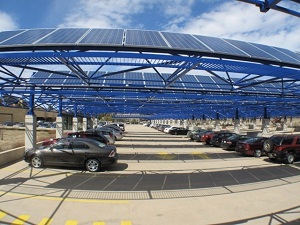Epic Systems Corp. gets 3 for 1 with new solar array
 Epic Systems, a Wisconsin-based developer of electronic medical record software, is developing a new 2.2 megawatt photovoltaic array (the largest in Wisconsin) over active farming land—and adding in geothermal wells for heating and cooling. It’s a triple-action plan that helps the company in its ultimate quest to become self-sustaining.
Epic Systems, a Wisconsin-based developer of electronic medical record software, is developing a new 2.2 megawatt photovoltaic array (the largest in Wisconsin) over active farming land—and adding in geothermal wells for heating and cooling. It’s a triple-action plan that helps the company in its ultimate quest to become self-sustaining.
Epic began work on the new array even as it was finishing construction of a 1,300 module photovoltaic array covering a parking deck at its Verona, Wis., campus. When the new array is completed, the campus will get about 25 percent of its energy from the arrays, said Bruce Richards, Epic's director of facilities.
The project, part of which will come online this year, with the rest coming online in 2012, is being built by J.H. Findorff & Son Inc.
“Our goal is to become self sufficient. We’re attempting to get off the grid. We’re looking at biomass and we’re looking at wind,” Richards said. “We already collecting our yard-waste; we’re looking to harvest gas off that.”
They’re also studying the site’s potential for wind development, according to Richards. The company will continue to expand the renewable generation until it reaches the break-even point. As it builds out more, it will build out more renewable energy as well.
But the new solar system includes some extra features to get even more use out of the 18-acre plot of farmland Epic owns. First of all, the array is being built on structures 13 feet above the ground.
“They’re spaced appropriately, so we still get sun to the pants underneath and high enough allowing farm equipment to go under,” Richards said. “You’ve got to realize, you won’t get as good a yield. But there’s enough sunlight that we will be able to grow crops.”
It’s likely that alfalfa will be the first crop, but in the future, other crops could be rotated in and out.
Epic’s also drilling geothermal wells, which the company will use to provide heating and cooling.
“We’re adding another 2,000 wells for future expansion that we’re planning. In fact today, the only area we don’t have geothermal doing heating and cooling is our main auditorium,” Richards said.
The auditorium already had existing heating and cooling installed, which would make geothermal heating and cooling for the facility economically unfeasible. A full 98 percent of the campus’ heating and cooling already comes from 3,600 geothermal wells the company previously dug.
“This is really an exciting thing for all the people that work here too,” Richards said. “We’ve got a very young group of people here. People are just environmentally sensitive. The whole process is driven around the environment here.”
Image courtesy of project developer J.H. Findorff & Son Inc.



